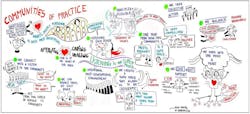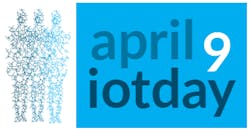Sometimes while teaching we become the ones who are taught. From time to time we get reminded of our roots, and in a flash the building blocks of our industry's' composition and structure are laid bare.
Therese Sullivan has captured one of those moments during a session, Smart Building Automation Evolution from Ethernet to Emotion at the recent AHRExpo Atlanta. (Therese Sullivan is the Customer Marketing Leader for Tridium, working to facilitate a two-way conversation between the Niagara Community of Practice and the company. She’s been in this role for eight months and has been a thought leader in the industry for years.)
She explained the importance of the many “Communities of Practice” that are the building blocks of our industry. These CoP are part of how we are Disrupting Disruption and our Automated Intelligence with Autonomous Interactions.
We need to better understand how to best use existing CoP and create new Communities of Practice in all we do.
Therese wrote in a recent article:
As part of the 2019 AutomatedBuildings AHR Education Program, I participated in a panel discussion about the evolution of the building automation industry. There, I commented that new technology – even one that is incrementally better in some ways than whatever exists – amounts to little, unless a Community of Practice (CoP) grows around it. Ken Sinclair and a few members of the audience that day asked that I expand on what I meant by ‘Community of Practice.’ Here is that explanation:
(We borrowed this Graphic illustration by Nitya Wakhlu, produced at the Experience Engagement conference in October 2015.)
The pace of technological change in how we operate buildings and the scarcity of building engineering talent is causing many in our industry to consider ways to inspire faster learning. In the early 1990s, just as the internet was starting to enable virtual meet-ups of people with common interests, a team of cognitive anthropologists, Jean Lave and Etienne Wenger, observed that the learning of enterprise workers accelerated when people with common professional roles formed a community and shared knowledge. They didn’t need to be working in the same company or sitting in proximity to unite around a craft or a toolset and begin improving their collective knowledge and making that domain better in the process. They termed this coming together a Community of Practice (CoP).
Therese started as our contributing editor over six years ago and helped create this 15-year anniversary document, 15 Years in the Collaboratory, while convincing us Automated Buildings.com was an industry collaboratory, an online Community of Practice. She identified back then the value of community:
In celebration of our 15th year online we have requested fresh eyes to extract the evolutionary stories of our industry told in her own words. Therese Sullivan our newest contributing editor has taken on the task to provide a new perspective and insight as to why these articles and interviews are important, and carefully represents them in a timeline to show our Automated Buildings industries' evolution. In her own words, she connects, timelines, and provides fresh comments on major events of our history in her 15 Years in the Collaboratory.
Therese in her articles – both on our web site and her own -- always brought out the importance of the people side of our industry. For another example we turn to this article from Building Context, Will Devops Culture Come to Smart Buildings?:
If software is eating the world, then software development operations should be of consuming interest to everyone—particularly to stakeholders in Smart Buildings and other Smart Systems. We should have already learned the lesson that you need to start product development from the perspective of end-users—building owners, facilities staff and occupants. The last generation of building automation technology offered enough instances of unplugged BMS systems sitting in corners to be wary of the possibility of not-my-piece-of-cake reactions to new technology. How can the industry do better going forward? Or as Brad White of SES Consulting asked in April “How do you spec a good user experience?”
Therese was very involved in helping pull together a New Community of Practice that was rapidly evolving called Project-Haystack (https://project-haystack.org). The Project as an amazing example of a community of Practice that has changed and is still changing the world.
The history of its evolution is summarized in this article, How to Build a Haystack, and it is an amazing example of how a Community of Practice comes into being. And of course, the longer these communities exist and grow the greater their value.
Where is my example Community Of Practice today? We actually ran a piece on the development of Project Haystack's new marketing web site from their Marketing Manager Robin Bestel, just because it demonstrates the growing acceptance of the value of the Haystack methodology,
Here's a history lessen from an article I wrote all the way back in 2002, WE The People:
For the necessary changes in our industry to occur it will take the total effort of "We the People" to ensure the transition is all that it can be. I am often asked, "Who is driving the web integration that is presently revolutionizing our industry?" The answer is "We the people of the large building automation industry". That includes you! There are no secret organizations or committees spearheading the revolution, it is simply happening.
It is We The People who create Communities Of Practice
And how long does it take to build a community of practice?
A great example in our industry is BACnet - A Data Communication Protocol for Building Automation and Control Networks. Developed under the auspices of the American Society of Heating, Refrigerating and Air-Conditioning Engineers (ASHRAE), BACnet is an American national standard, a European standard, an ISO global standard and a national standard in more than 30 countries. The protocol is supported and maintained by ASHRAE Standing Standard Project Committee 135.
These two articles tell of the history of BACnet over the last 40 years:
40 years of evolution in Building Automation
Web Control History(Automated Logic Corporation took the industry from BACnet to web-based controls in the early 1980s')
Enough history! So how are these Communities of Practice shaping our world? In this recent article, Automated Intelligence with Autonomous Interactions, we discuss the Communities of Practice and in the later part the value of Haystack and creating new CoPs.
Ruairi Barnwell who leads the (Building Optimization Enterprise within the DLR Group) and I discussed the value of CoP during a recent podcast of Control Talk NOW. We tallked about CoPs as part of our daily job and the constant need to create New Smart Building CoPs in every major city.
Ruairi tells how he has reinvented his company using his community of practice, Project-Haystack.org, and how he is building new communities of practice in most major cities around smart buildings — a great success story to inspire is all.
We all need to better understand the power of the virtual mediums such as You-tube, LinkedIn, Twitter and other social networks.
All have a compelling immediacy, but all make it difficult if not impossible to communicate their findings and conclusions after discussions have occurred. All are great platforms for assembling new CoP, however the communication needs to be cross-platform to be successful. According to George Bernard Shaw, the single biggest problem in communication is the illusion that it has taken place.
It is our job as the creators of communities of practice to pull out the best of the best discussions while identifying our source, adding perspective and presenting it in a cross-platform medium (such as HTML) so that it can be reintroduced back into our discussions.
We need to shift through the Haystack of life separating the wheat from the chaff, bagging and baling only the best in our articles/interviews so the concentrated collected curated information with its referenced discussions can be useful while preventing the complete stack from turning to, well, manure. (Sorry, I grew up as a farm kid so my analogies are bit homey an oversimplified.)
This book is of interest, Building Successful Communities of Practice by Emily Webber. From the summary on Goodreads:
Connecting with other people, finding a sense of belonging and the need for support are natural human desires. Employees who don't feel supported at work don't stay around for long - or if they do, they quickly become unmotivated and unhappy. At a time when organisational structures are flattening and workforces are increasingly fluid, supporting and connecting people is more important than ever. This is where organisational communities of practice come in. Communities of practice have many valuable benefits. They include accelerating professional development; breaking down organisational silos; enabling knowledge sharing and management; building better practice; helping to hire and retain staff; and making people happier. In this book, Emily Webber shares her learning from personal experiences of building successful communities of practice within organisations. And along the way, she gives practical guidance on creating your own.
A CoP I am part of is the European IoT Council (https://www.theinternetofthings.eu/) which has an amazing scope of practice:
The Council is a formidable, unique network of talents encompassing all skills, experiences and trades, from entrepreneurship to philosophy, public sector and private sector, and it brings together people who beyond their specific knowledge share the same passion of tinkering with technology to put it at the service of individuals, communities, society, and the whole planet. The IoT Day is an irresistible momentum enabling IoT lovers to meet, share, co-create, present solutions, and find new problems to work on ;-) ...The future is not purely destiny; it is in our hands. - Gérald Santuci
We are Celebrating IoT Day https://www.iotday.org.
Iotday April 9 2019 The day to celebrate, as this article I recently wrote puts it, Desirable Delicious Delightful Disruption:
Disruption Is an opportunity to question what we are doing and why we are doing IT. IoT provides a new way of doing it. We need not to just watch this process of disruption we need to be the disruption. I have written much about and linked many resources but have not included a celebration of disruption.
This post for the women's CoP for International Women's Day in the BAS Industry features Therese and several others.
I hope that Therese and I have instilled the importance of being part of and creating "Communities of Practice" as it has been a core value of my 50-year journey in Building Automation.
About the Author
Ken Sinclair
Editor/Owner/Founder
Ken Sinclair has been called an oracle of the digital age. He sees himself more as a storyteller and hopes the stories he tells will be a catalyst for the IoT future we are all (eventually) going to live. The more than 50 chapters in that ongoing story of digital transformation below are peppered with HTML links to articles containing an amazing and diverse amount of information.
Ken believes that systems will be smarter, self-learning, edgy, innovative, and sophisticated, and to create, manage and re-invent those systems the industry needs to grow our most important resource, our younger people, by reaching out to them with messages about how vibrant, vital and rewarding working in this industry can be.


